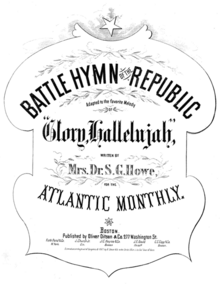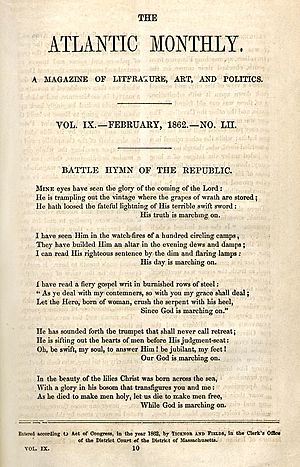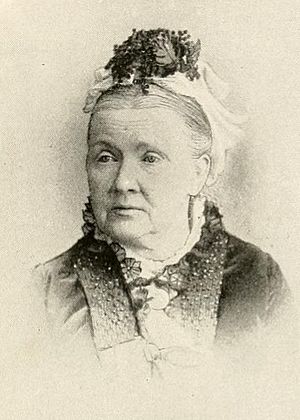Battle Hymn of the Republic facts for kids

Cover of the 1863 sheet music for the "Battle Hymn of the Republic"
|
|
| Lyrics | Julia Ward Howe, 1861 |
|---|---|
| Music | William Steffe, 1856; arranged by James E. Greenleaf, C. S. Hall, and C. B. Marsh, 1861 |
The "Battle Hymn of the Republic" is a very famous American patriotic song. It's also known as "Mine Eyes Have Seen the Glory" or "Glory, Glory Hallelujah". An abolitionist writer named Julia Ward Howe wrote the lyrics. Abolitionists were people who wanted to end slavery.
Julia Ward Howe wrote her song in November 1861. She based it on a popular soldiers' song called "John Brown's Body". Her version was first printed in a magazine called The Atlantic Monthly in February 1862. Howe's song connected the Union's fight in the American Civil War to God's plan for justice.
Julia Ward Howe was married to Samuel Gridley Howe. He was a scholar who worked to educate blind people. Both Julia and Samuel were active in politics against slavery. They strongly supported the Union side during the Civil War. Samuel Howe was even part of a secret group that helped fund John Brown, who fought against slavery.
Contents
History of the Song
From Old Hymns to Soldiers' Chants
The tune and some words of "John Brown's Body" came from a much older folk hymn. This hymn was called "Say, Brothers will you Meet Us". It was also known as "Glory Hallelujah". This tune became popular at religious gatherings called "camp meetings" in the late 1700s.
One early version of the song had the words "Oh! Brothers will you meet me / On Canaan's happy shore?". The chorus was "There we'll shout and give Him glory / For glory is His own." By the 1850s, this changed into the familiar "Glory, glory, hallelujah" chorus. The tune and these words spread across both the northern and southern United States.
The "John Brown's Body" Song
On May 12, 1861, at Fort Warren near Boston, the song "John Brown's Body" was played publicly. This was shortly after the American Civil War began. It used the "Oh! Brothers" tune and the "Glory, Hallelujah" chorus.
In 1890, a man named George Kimball shared how soldiers made up the lyrics to "John Brown's Body". He was in the 2nd Infantry Battalion of the Massachusetts militia. They had a soldier named John Brown, who shared the same name as the famous anti-slavery fighter.
Kimball said that soldiers would joke with their John Brown. If he was late, they'd say things like, "Come, old fellow, you ought to be at it if you are going to help us free the slaves." Or, "This can't be John Brown—why, John Brown is dead." Then someone would add, "Yes, yes, poor old John Brown is dead; his body lies mouldering in the grave."
These jokes became common sayings among the soldiers. Slowly, they put these sayings to the tune of "Say, Brothers." Kimball explained that silly rhymes about John Brown's body decaying were sung to the hymn's music.
Eventually, they came up with the lines:
And:
Soldiers loved the idea that John Brown's soul was "marching on." They sang these lines with great energy, always adding the "Glory, hallelujah" chorus. Some leaders thought the words were too rough, but the soldiers kept singing them.
How the "Battle Hymn" Was Created
George Kimball's battalion was sent to Murray, Kentucky, early in the Civil War. Julia Ward Howe heard the "John Brown's Body" song during a troop review near Washington, D.C. Her friend, the Reverend James Freeman Clarke, suggested she write new words for the soldiers' song.
On the night of November 18, 1861, Julia Ward Howe wrote the verses for the "Battle Hymn of the Republic." She later remembered how it happened:
I went to bed that night as usual, and slept... I awoke in the gray of the morning twilight; and as I lay waiting for the dawn, the long lines of the desired poem began to twine themselves in my mind. ...I must get up and write these verses down, lest I fall asleep again and forget them. So, with a sudden effort, I sprang out of bed, and found in the dimness an old stump of a pencil... I scrawled the verses almost without looking at the paper.
Howe's "Battle Hymn of the Republic" was first printed in The Atlantic Monthly in February 1862. She wrote a sixth verse, but it was not published at that time.

Lyrics
Julia Ward Howe sent her lyrics to The Atlantic Monthly. They were first published in the magazine's February 1862 issue.
First Published Version
Mine eyes have seen the glory of the coming of the Lord;
He is trampling out the vintage where the grapes of wrath are stored;
He hath loosed the fateful lightning of His terrible swift sword:
His truth is marching on.
(Chorus)
Glory, glory, hallelujah!
Glory, glory, hallelujah!
Glory, glory, hallelujah!
His truth is marching on.
I have seen Him in the watch-fires of a hundred circling camps,
They have builded Him an altar in the evening dews and damps;
I can read His righteous sentence by the dim and flaring lamps:
His day is marching on.
(Chorus)
Glory, glory, hallelujah!
Glory, glory, hallelujah!
Glory, glory, hallelujah!
His truth is marching on.
I have read a fiery gospel writ in burnished rows of steel:
"As ye deal with my contemners, so with you my grace shall deal";
Let the Hero, born of woman, crush the serpent with his heel,
Since God is marching on.
(Chorus)
Glory, glory, hallelujah!
Glory, glory, hallelujah!
Glory, glory, hallelujah!
His truth is marching on.
He has sounded forth the trumpet that shall never call retreat;
He is sifting out the hearts of men before His judgment-seat;
Oh, be swift, my soul, to answer Him! Be jubilant, my feet!
Our God is marching on.
(Chorus)
Glory, glory, hallelujah!
Glory, glory, hallelujah!
Glory, glory, hallelujah!
Our God is marching on.
In the beauty of the lilies Christ was born across the sea,
With a glory in His bosom that transfigures you and me.
As He died to make men holy, let us die to make men free,
While God is marching on.
(Chorus)
Glory, glory, hallelujah!
Glory, glory, hallelujah!
Glory, glory, hallelujah!
Our God is marching on.
- Many modern versions of the "Battle Hymn" use the lyric "As He died to make men holy, let us live to make men free." This is different from Julia Ward Howe's original wartime lyric: "let us die to make men free."
Other Versions of the Lyrics
Howe's first handwritten copy was a bit different from the published song. It included an extra verse at the end:
He is coming like the glory of the morning on the wave,
He is Wisdom to the mighty, He is Succour to the brave,
So the world shall be His footstool, and the soul of Time His slave,
Our God is marching on.
(Chorus)
Glory, glory, hallelujah!
Glory, glory, hallelujah!
Glory, glory, hallelujah!
Our God is marching on!
In the 1862 sheet music, the chorus always started with:
Glory! Glory! Hallelujah!
Glory! Glory! Glory! Hallelujah!
Glory! Glory! Hallelujah!"
Recordings and Public Performances
| "Battle Hymn of the Republic" | |
|---|---|
| Single by Mormon Tabernacle Choir | |
| B-side | "The Lord's Prayer" |
| Released | 1959 |
| Recorded | 1959 |
| Genre | Choral |
| Length | 3:07 |
| Label | Columbia |
| Songwriter(s) | Peter Wilhousky |
- In 1953, Marian Anderson sang the song for 60 million TV viewers. It was part of The Ford 50th Anniversary Show.
- In 1960, the Mormon Tabernacle Choir won a Grammy Award for their performance. Their song became a commercial success. It reached #13 on Billboard's Hot 100 chart.
- Judy Garland performed this song on her TV show in December 1963. She wanted to honor President John F. Kennedy after he was assassinated.
- Andy Williams had a hit with an a cappella version in 1968. He sang it at Senator Robert Kennedy's funeral. His version reached #33 on the Billboard Hot 100.
- Anita Bryant sang it at the halftime show of Super Bowl V in 1971. She also sang it at the burial of President LBJ in 1973.
- The song is part of "An American Trilogy". This is a song medley written by Mickey Newbury in 1971. Elvis Presley made it very popular in his concerts.
- It was performed at St. Paul's Cathedral on September 14, 2001. This was a memorial service for those lost in the September 11, 2001 attacks.
Influence of the Song
Popularity and Wide Use
Since the American Civil War, "The Battle Hymn of the Republic" has been a very popular American patriotic song. It is often used to show national pride.
Cultural Impact
The words of "Battle Hymn of the Republic" appeared in Dr. Martin Luther King Jr.'s speeches. He used them in his "How Long, Not Long" speech in 1965. He also used them in his final sermon, "I've Been to the Mountaintop", in 1968. King's last public words ended with the song's first lyrics: "Mine eyes have seen the glory of the coming of the Lord."
Bishop Michael B. Curry also quoted the song in 2015. He was the first African American Presiding Bishop of The Episcopal Church. He used the song's lyrics to share a message about God's love.
The words "Mine eyes have seen the glory of the coming of the Lord" are written at the American Cemetery in Normandy, France. This is a place that honors fallen soldiers.
The tune has been used in many movies. These include the 1970 war comedy Kelly's Heroes and the 1999 sci-fi western Wild Wild West. The first verse inspired the title of John Steinbeck's famous book The Grapes of Wrath. The title of John Updike's In the Beauty of the Lilies also came from this song.
In Sports
The chorus "Glory, glory, hallelujah!" has been adopted by fans of many sports teams. This is especially true in English and Scottish soccer leagues. Tottenham Hotspur fans started using it in 1961. They sang "Glory, glory, hallelujah" when their team won a big game.
Other teams like Hibernian, Leeds United, and Manchester United also started using "Glory, Glory..." with their team names. This tradition spread to other sports and countries. For example, the Australian Rugby League team, the South Sydney Rabbitohs, sing "Glory, Glory to South Sydney."
Other Songs Using This Tune
Many other songs use the melody of "Battle Hymn of the Republic." Some even use parts of its lyrics.
- "Marching Song of the First Arkansas" was a Civil War song. It had a similar style and was a strong statement of black pride.
- The University of Georgia's rally song, "Glory Glory to Old Georgia", uses the tune. It has been sung at American college football games since 1909. Other colleges, like Auburn University and the Colorado Buffaloes, also use songs with this tune.
- In 1901, Mark Twain wrote "The Battle Hymn of the Republic, Updated". It used the same tune to comment on the Philippine–American War.
- "The Burning of the School" is a well-known funny version of the song.
- The United States Army paratrooper song, "Blood on the Risers", uses "Gory, gory" instead of "Glory, glory."
- Many soccer chants in Britain use the tune. Fans often sing "Glory, Glory..." plus their team's name.
- In Australia, the South Sydney Rabbitohs rugby league club uses "Glory Glory to South Sydney."
- The song "Jesus Can't Play Rugby" is a popular funny song sung at informal sports events. It uses the traditional melody.
- "Gloria, Gloria Labandera" is a protest song from the Philippines. It used the tune to make fun of a former president.
Other songs simply use the melody, without any lyrical connection to "The Battle Hymn of the Republic":
- "Solidarity Forever" is a marching song for organized labor from the 20th century.
- The anthem of the American consumers' cooperative movement, "The Battle Hymn of Cooperation", written in 1932.
- The tune is used as a marching song in the Finnish military.
- Finnish Ice Hockey fans sing the tune with words meaning "Finland will soon score, and no one can do anything about it."
- The Estonian song "Kalle Kusta" also uses the melody.
- The popular folk dance "Gólya" ("Stork") from Hungary uses the same tune.
- The melody is used in the British nursery rhyme "Little Peter Rabbit."
- The melody is used in a French Canadian Christmas carol called "Glory, Alleluia."
- The melody is used in the marching song of the Assam Regiment of the Indian Army: "Badluram ka Badan".
- The song "Belfast Brigade" uses alternate lyrics and is sung in support of the Irish Republican Army.
- The song "Up Went Nelson", celebrating the destruction of Nelson's Pillar in Dublin, is sung to this tune.
- The Subiaco Football Club in Australia uses the song as their team song.
- The melody is used in the Dutch children's song "Lief klein konijntje" about a rabbit.
- The melody is used as the theme for the Japanese electronics chain Yodobashi Camera.
- The melody is used as a nursery rhyme in Japan as ともだち讃歌 ("Tomodachi Sanka").
- The melody is used as a fight song at Queen's University in Canada, called "Oil Thigh".
- The melody is used in Christmas carols in Indonesia.
- The melody is used in "Hãy tiếp tục đoàn kết với Việt Nam" (Let's continue to unite with Vietnam), a song about the Sino-Vietnamese war of 1979.
See also
 In Spanish: The Battle Hymn of the Republic para niños
In Spanish: The Battle Hymn of the Republic para niños
- "Battle Cry of Freedom"
- "Belfast Brigade"
- "Blood on the Risers"
- Children's street culture
- "Glory, Glory" (Georgia fight song)
- "Solidarity Forever"
- William Weston Patton
- "Dixie", a famous song from the Confederate side.


